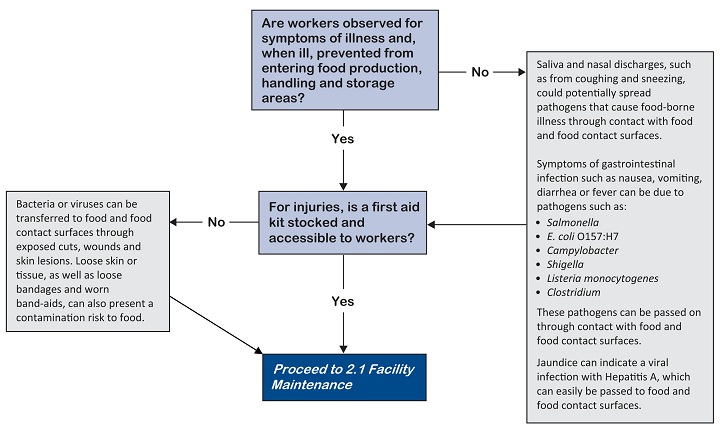Worker policies - 1.4 Injuries and illness
Workers who have open cuts, sores and wounds or suffer from an illness that can be transferred to food, (for example hepatitis A) can pose a food safety risk.

This good agricultural practice applies to farms with workers who milk livestock, or handle eggs, honey, fruits, nuts or vegetables.
What needs to be done
Make sure workers with open cuts or wounds or displaying symptoms of illness do not enter any food production or handling areas without taking appropriate measures to prevent contamination.
How to do it
Establish practices to handle worker illness or injury.
To avoid contaminating food, make sure workers take the following precautions:
- Protect all open cuts and wounds securely with waterproof bandages or coverings
- Change all coverings frequently
- Report all cuts and wounds sustained in the workplace to the employer immediately for appropriate first aid and application of protective coverings
When a worker is showing signs of illness, make sure they do not handle food. Symptoms could include:
- Skin lesions (boils or sores)
- Diarrhea
- Vomiting
- Fever
- Jaundice (yellowing of skin or eye colour)
- For farms with paid workers, have at least one worker with a valid first aid certificate present during production times
Keep first aid kits well stocked and readily available to workers. First aid kits and stations should contain:
- A current edition of a standard St. John Ambulance First Aid Manual
- Safety pins
- Bandages (individually wrapped, larger field dressings)
- Sterile gauze (pads and rolls)
- Encourage workers to report all cuts, wounds and illnesses and take appropriate measures
When you suspect food has become contaminated due to worker injury or illness, seek advice on the best course of action (for example, a possible recall, cleaning and sanitizing, or disposal options).
If you need an audit
Be prepared for a possible request from the auditor to review:
- Stocked first aid kits available for workers
- Written practices to deal with suspected contaminated product and proper sanitation of affected equipment and area
- Valid certificate(s) of worker(s) with first aid training
Laws and regulations
There are few specific agricultural laws that impact on food safety regulating persons with injuries or wounds on-farm. Generally, these requirements are laid out in laws regarding the processing of meat, fish and other food products, which are outside the scope of this document.
Milk Industry Act, R.S.B.C. 1996, c. 289, s. 10 (1) requires persons who suffer or recover from any infectious disease must not, within a time prescribed by the regulations under the Public Health Act, milk or handle milk.
Occupational Health and Safety Regulation, Reg. 296/97, s. 3.15-3.21 under the Workers Compensation Act set out the requirements for first aid services at workplace, including the first aid attendant qualifications and responsibilities, first aid procedures and records.
